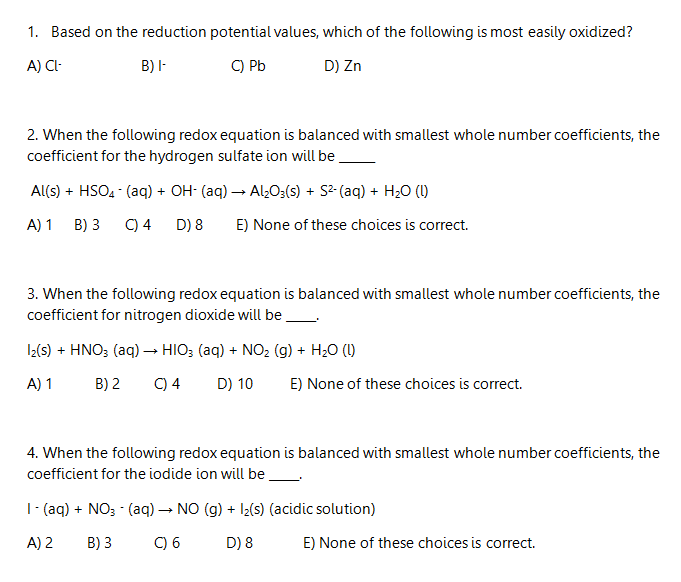Chemistry: An Atoms First Approach
2nd Edition
ISBN:9781305079243
Author:Steven S. Zumdahl, Susan A. Zumdahl
Publisher:Steven S. Zumdahl, Susan A. Zumdahl
Chapter17: Electrochemistry
Section: Chapter Questions
Problem 80E: An electrochemical cell consists of a nickel metal electrode immersed in a solution with [Ni2+] =...
Related questions
Question
please answer no. 1-4 :)

Transcribed Image Text:1. Based on the reduction potential values, which of the following is most easily oxidized?
A) Cl-
B) I-
C) Pb
D) Zn
2. When the following redox equation is balanced with smallest whole number coefficients, the
coefficient for the hydrogen sulfate ion will be
Al(s) + HSO4 - (aq) + OH- (aq) → Alz03(s) + S2 (aq) + H2O (1)
A) 1
B) 3
C) 4
D) 8
E) None of these choices is correct.
3. When the following redox equation is balanced with smallest whole number coefficients, the
coefficient for nitrogen dioxide will be.
I2(s) + HNO3 (aq) → HIO; (aq) + NO2 (g) + H20 (1)
A) 1
B) 2
C) 4
D) 10
E) None of these choices is correct.
4. When the following redox equation is balanced with smallest whole number coefficients, the
coefficient for the iodide ion will be
|- (aq) + NO3 - (aq) → NO (g) + Iz(s) (acidic solution)
A) 2
B) 3
C) 6
D) 8
E) None of these choices is correct.
Expert Solution
This question has been solved!
Explore an expertly crafted, step-by-step solution for a thorough understanding of key concepts.
This is a popular solution!
Trending now
This is a popular solution!
Step by step
Solved in 2 steps

Knowledge Booster
Learn more about
Need a deep-dive on the concept behind this application? Look no further. Learn more about this topic, chemistry and related others by exploring similar questions and additional content below.Recommended textbooks for you

Chemistry: An Atoms First Approach
Chemistry
ISBN:
9781305079243
Author:
Steven S. Zumdahl, Susan A. Zumdahl
Publisher:
Cengage Learning

Chemistry
Chemistry
ISBN:
9781305957404
Author:
Steven S. Zumdahl, Susan A. Zumdahl, Donald J. DeCoste
Publisher:
Cengage Learning


Chemistry: An Atoms First Approach
Chemistry
ISBN:
9781305079243
Author:
Steven S. Zumdahl, Susan A. Zumdahl
Publisher:
Cengage Learning

Chemistry
Chemistry
ISBN:
9781305957404
Author:
Steven S. Zumdahl, Susan A. Zumdahl, Donald J. DeCoste
Publisher:
Cengage Learning


Chemistry: Principles and Reactions
Chemistry
ISBN:
9781305079373
Author:
William L. Masterton, Cecile N. Hurley
Publisher:
Cengage Learning

General Chemistry - Standalone book (MindTap Cour…
Chemistry
ISBN:
9781305580343
Author:
Steven D. Gammon, Ebbing, Darrell Ebbing, Steven D., Darrell; Gammon, Darrell Ebbing; Steven D. Gammon, Darrell D.; Gammon, Ebbing; Steven D. Gammon; Darrell
Publisher:
Cengage Learning

Chemistry by OpenStax (2015-05-04)
Chemistry
ISBN:
9781938168390
Author:
Klaus Theopold, Richard H Langley, Paul Flowers, William R. Robinson, Mark Blaser
Publisher:
OpenStax